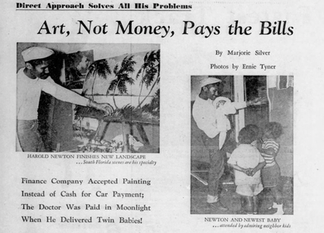HAROLD NEWTON
(1934-1994)
James "Harold" Newton was born in 1934 in Gifford, Florida before he and his family move to Tifton, Georgia around 1940. He always had a passion for art, and in 7th grade he started painting religious scenes on velvet (popular in South Georgia in the 1940s). He moved to Gifford in 1950 to help support his family by working in the orange groves. In returning home to Florida, his whole life (like his geography) was about to change.
Harold endured the hard labor and helped support his family by working in the citrus groves in the early 1950s. It wasn't until 1954 that he met the renowned Florida landscape artist Albert "Bean" Backus at his studio on Avenue C in Fort Pierce. Beanie Backus (who was known for his open door policy to those from all walks of life) would let Harold watch him paint in his studio, quietly learning by osmosis. While never formally training Harold, Backus invited Harold to observe him while working, mesmerized by his palette knife technique and color mixing. These early "Backus Studio" pieces by Harold are often on Canvas Board and Upson.
It was in these early years from 1954-1958 that Harold refined his technique and grew into his style as an artist. He had become popular in the Gifford and Ft. Pierce area as a young and talented artist, with unique sales skill and ambition. When he began his career he sold paintings for $20-$30, which was far more than a days wage in the orange groves. However, because of his skill, he was the first Highwaymen artist to achieve higher prices and over the years he could get $75-$100 for a single painting. He approached businesses, banks, government offices, and even homes along the east coast selling paintings door to door. One of the earliest and coolest stories from locals even recalls Harold Newton riding his bicycle down A1A or US1 trying to sell his paintings.
Harold always took great pride in his work, so he often stayed away from the "fast-grass" style of painting that Alfred pioneered. While the money was important, he pushed himself and those he taught to always care for the art that they created. Along with his signature came a standard of quality on any piece he painted, which is why his paintings remain some of the most appealing and valuable today.
As the official "First Florida Highwaymen", Harold was responsible for teaching many of the other members how to paint. Roy McLendon was his neighbor and first learned a from Harold. Mary Ann Carroll first started when she saw Harold painting in his yard. Harold taught both of his younger brothers Sam and Lemuel to paint in the classic "Newton" style that he created. The list goes on to include Livingston Roberts, Willie Daniels, and more.
An excerpt from one of the first informational websites on the Highwaymen, The Highwaymen Trail:
"Increasingly he took to the roads north. He sold to doctors, lawyers, and businesspeople. Late in a day of sales, he would allow his paintings to go for lower prices. Rarely did he return home with unsold works. Word of mouth spread and sometimes customers came looking for him. He frequently exchanged his landscapes for car payments and other pending expenses such as rent. When his twins were born, he paid the hospital bills with some of his works, and they were displayed on the hospital walls. Harold, like several other Highwaymen, was able to get out of legal trouble in exchange for his paintings. Once when he was pulled over for speeding on Indian River Drive and couldn’t post bond, he got the money after selling two paintings to the deputy sheriff. He even had a little cash left over from the sale."
Harold Newton passed away following a debilitating stroke in 1994. It was in the wake of his passing that the Highwaymen story was uncovered and the first few articles published by Jim Fitch and Jeff Klinkenberg. Unfortunately Harold Newton never got to see the story he created, but his legacy lives on as the First and Original Highwayman.
Biographies are adapted from those on thehighwaymentrail.com, one of the earliest informative websites on the Florida Highwaymen. Since the site is no longer active, we have provided them here.






























